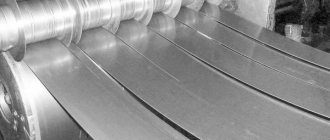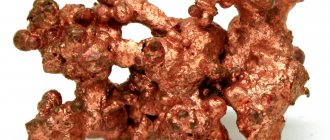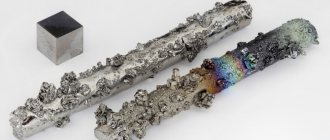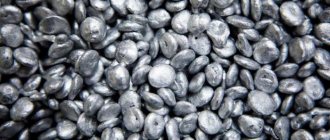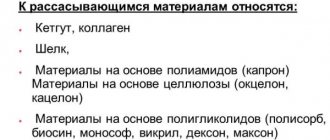BRANDS
1.1. Depending on the chemical composition, tin-lead solders are manufactured in the following grades:
antimony-free - POS 90, POS 63, POS b1, POS 40, POS 30, POS 10, POS 61M, POSK 50-18, POSK 2-18; low antimony - POSSU 61-0.5, POSSU 50-0.5, POSSU 40-0.5, POSSU 35-0.5, POSSU 30-0.5, POSSU 25-0.5, POSSU 18-0.5 ; antimony - POSSU 95-5, POSSU 40-2, POSSU 35-2, POSSU 30-2, POSSU 25-2, POSSU 18-2, POSSU 15-2, POSSU 10-2, POSSU 8-3; POSSU 5-1, POSSU 4-6, POSSU 4-4.
Examples of catch designations: Solder in ingots grade POS 40: Solder Ch POS 40 GOST 21930-76 The same, grade POSSu 18-0.5: Solder Ch POSSu 18-0.5 GOST 21930-76
Tin-lead solder
Health Hazard: Lead solder contains lead. When ingested, lead accumulates in the body's fatty tissues, including the myelin sheath that surrounds the nerve fibers of the brain. This can cause brain damage, especially in infants and young children. This is mainly a lead casting problem where the lead is heated to near boiling point. The temperatures used for soldering are much lower. The main risk of lead exposure comes from lead that rubs off from solder onto your fingers. Please make sure you do not eat or drink while soldering. Wash your hands thoroughly when you finish soldering.
Three lead-based alloys are commonly used for electronic soldering:
60/40 (Sn/Pb) . The main advantage of 60/40 solder is cost, which is why most older equipment was built using this type of solder. The main disadvantage of this alloy is that it has a plastic region of 5 ºC. 60/40 solder becomes ductile (malleable but not completely molten) at 183ºC and melts at 188ºC. The solder passes through the same plastic area as it cools, and if the connection breaks or moves as the solder passes through the plastic area, a cold solder joint is created. This can make hand soldering a frustrating experience, especially for beginners. As long as the solder joint remains stationary until the solder has completely solidified, the ductile region has no practical consequences for solder joints.
63/37 (Sn/Pb) . 63/37 solder is a eutectic alloy, which means it changes directly from solid to liquid without ductility. Solder 63/37 melts at 183 ºC. This type of solder is a little more expensive than 60/40, but the lack of ductile area makes it easier to work with and more beginner-friendly. Joints made with this solder will appear shinier than joints made with 60/40 solder. This is a purely cosmetic effect.
62/36/2 (Sn/Pb/Ag) . 62/36/2 "silver" solder is gaining popularity in audio circles - perhaps because it is more expensive and contains silver. For soldering on copper wires and circuit boards, there is no evidence that "silver" solder should be superior to regular 60/40 or 63/37 solder. However, if you are soldering to silver wire, including some mica caps and silver-on-steel RF cables, you can use "silver" solder. This is because regular Sn/Pb solder will dissolve the silver over time. Solder 62/36/2 prevents this.
In terms of conductivity, the three types are within a few percent of each other. The tensile strength of 62/36/2 solder is approximately twice as high as 60/40, but this depends on the mechanically stronger solder joints and on the geometry of the joint.
TECHNICAL REQUIREMENTS
2.1. Tin-lead solders in ingots are manufactured in accordance with the requirements of this standard according to technological instructions approved in the prescribed manner. The chemical composition of solders must comply with the requirements of the table.
2.2. The shape of solder ingots of all grades is given in Appendix 3. The dimensions of the ingots specified in Appendix 3 are given for the design and manufacture of molds. Permissible deviations in mold dimensions must correspond to accuracy class 13 according to GOST 26645.
| Chemical composition, % | ||||||
| Solder grade | OKP code | Main components | ||||
| Tin | Antimony | Cadmium | Copper | Lead | ||
| Antimony-free | ||||||
| POS 90 | 17 2311 1100 04 | 89-91 | — | — | — | The rest is the same |
| POS 63 | 17 2312 0100 | 62,5-63,5 | — | — | — | « |
| POS 61 | 17 2312 1100 10 | 59-61 | — | — | — | « |
| POS 40 | 17 2314 1100 00 | 39-41 | — | — | — | « |
| POS30 | 17 2321 1100 09 | 29-31 | — | — | — | « |
| POS 10 | 17 2326 1100 06 | 9-10 | — | — | — | « |
| POS 61M | 17 2312 1200 07 | 59-61 | — | — | 1,2-2,0 | « |
| POSK 50-18 | 17 2313 1200 02 | 49-51 | — | 17-19 | — | « |
| POSK 2-18 | 17 2343 1100 09 | 1,8-2,3 | — | 17,5-18,5 | — | « |
| Low antimony | ||||||
| POSSu 61-0.5 | 17 2312 1400 01 | 59-61 | — | — | — | The rest is the same |
| POSSu 50-0.5 | 17 2313 1100 05 | 49-51 | — | — | — | « |
| POSSu 40-0.5 | 17 2314 1200 08 | 39-41 | — | — | — | « |
| POSSu 35-0.5 | 17 2315 1200 03 | 34-36 | 0,05-0,5 | — | — | « |
| POSSU 30-0.5 | 17 2321 1200 06 | 29-31 | — | — | — | « |
| POSSu 25-0.5 | 17 2322 1200 01 | 24-26 | — | — | — | « |
| POSSu 18-0.5 | 17 2323 1100 10 | 17-18 | — | — | — | « |
| Antimony | ||||||
| POS 95-5 | 17 2311 1200 01 | Ost. | 4,0-5,0 | — | — | — |
| POSSu 40-2 | 17 2314 1300 05 | 39-41 | 1,5-2,0 | — | — | The rest is the same |
| POSSu 35-2 | 17 2315 1300 00 | 34-36 | 1,5-2,0 | — | — | « |
| POSSu 30-2 | 17 2321 1300 03 | 29-31 | 1,5-2,0 | — | — | « |
| POSSu 25-2 | 17 2322 1300 09 | 24-26 | 1,5-2,0 | — | — | « |
| POSSu 18-2 | 17 2323 1200 07 | 17-18 | 1,5-2,0 | — | — | « |
| POSSu 15-2 | 17 2324 1100 05 | 14-15 | 1,5-2,0 | — | — | « |
| POSSu 10-2 | 17 2326 1200 03 | 9-10 | 1,5-2,0 | — | — | « |
| POSSu 8-3 | 17 2326 1300 00 | 7-8 | 2,0-3,0 | — | — | « |
| POSSu 5-1 | 17 2327 1100 01 | 4-5 | 0,5-0,1 | — | — | « |
| POSSU 4-6 | 17 2327 1200 09 | 3-4 | 5,0-6,0 | — | — | « |
| POSSU 4-4 | 17 2327 1300 06 | 3-4 | 3,0-4,0 | — | — | « |
| Mass fraction, % | ||||||||||
| Solder grade | Impurities, no more | |||||||||
| Antimony-free | ||||||||||
| Antimony | Copper | Bismuth | Arsenic | Iron | Nickel | Sulfur | Zinc | Aluminum | Lead | |
| POS 90 | 0,10 | 0,05 | 0,1 | 0,01 | 0,02 | 0,02 | 0,02 | 0,002 | 0,002 | — |
| POS 63 | 0,05 | 0,05 | 0,1 | 0,02 | 0,02 | 0,02 | 0,02 | 0,002 | 0,002 | — |
| POS 40 | 0,10 | 0,05 | 0,2 | 0,02 | 0,02 | 0,02 | 0,02 | 0,002 | 0,002 | — |
| POS 30 | 0,10 | 0,05 | 0,2 | 0,02 | 0,02 | 0,02 | 0,02 | 0,002 | 0,002 | — |
| POS 10 | 0,10 | 0,05 | 0,2 | 0,02 | 0,02 | 0,02 | 0,02 | 0,002 | 0,002 | — |
| POS 61M | 0,20 | — | 0,2 | 0,01 | 0,02 | 0,02 | 0,02 | 0,002 | 0,002 | — |
| POSK 50-18 | 0,20 | 0,08 | 0,2 | 0,03 | 0,02 | 0,02 | 0,02 | 0,002 | 0,002 | — |
| POSK 2-18 | 0,05 | 0,05 | 0,2 | 0,01 | 0,02 | 0,02 | 0,02 | 0,002 | 0,002 | — |
| Low antimony | ||||||||||
| POSSu 61-0.5 | — | 0,05 | 0,2 | 0,02 | 0,02 | 0,02 | 0,02 | 0,002 | 0,002 | — |
| POSSu 50-0.5 | — | 0,05 | 0,1 | 0,02 | 0,02 | 0,02 | 0,02 | 0,002 | 0,002 | — |
| POSSu 40-0.5 | — | 0,05 | 0,2 | 0,02 | 0,02 | 0,02 | 0,02 | 0,002 | 0,002 | — |
| POSSu 35-0.5 | — | 0,05 | 0,2 | 0,02 | 0,02 | 0,02 | 0,02 | 0,002 | 0,002 | — |
| POSSu 30-05 | — | 0,05 | 0,2 | 0,02 | 0,02 | 0,02 | 0,02 | 0,002 | 0,002 | — |
| POSSu 25-0.5 | — | 0,05 | 0,2 | 0,02 | 0,02 | 0,02 | 0,02 | 0,002 | 0,002 | — |
| POSSu 18-0.5 | — | 0,05 | 0,2 | 0,02 | 0,02 | 0,02 | 0,02 | 0,002 | 0,002 | — |
| Antimony | ||||||||||
| POS 95-5 | — | 0,05 | 0,1 | 0,04 | 0,02 | 0,02 | 0,02 | 0,002 | 0,002 | 0,07 |
| POSSu 40-2 | — | 0,08 | 0,2 | 0,02 | 0,02 | 0,08 | 0,02 | 0,002 | 0,002 | — |
| POSSu 35-2 | — | 0,08 | 0,2 | 0,02 | 0,02 | 0,08 | 0,02 | 0,002 | 0,002 | — |
| POSSu 30-2 | — | 0,08 | 0,2 | 0,02 | 0,02 | 0,08 | 0,02 | 0,002 | 0,002 | — |
| POSSu 25-2 | — | 0,08 | 0,2 | 0,02 | 0,02 | 0,08 | 0,02 | 0,002 | 0,002 | — |
| POSSu 18-2 | — | 0,08 | 0,2 | 0,02 | 0,02 | 0,08 | 0,02 | 0,002 | 0,002 | — |
| POSSu 15-2 | — | 0,08 | 0,2 | 0,02 | 0,02 | 0,08 | 0,02 | 0,002 | 0,002 | — |
| POSSu 10-2 | — | 0,08 | 0,2 | 0,02 | 0,02 | 0,08 | 0,02 | 0,002 | 0,002 | — |
| POSSu 8-3 | — | 0,1 | 0,2 | 0,05 | 0,02 | 0,08 | 0,02 | 0,002 | 0,002 | — |
| POSSu 5-1 | — | 0,08 | 0,2 | 0,02 | 0,02 | 0,08 | 0,02 | 0,002 | 0,002 | — |
| POSSU 4-6 | — | 0,1 | 0,2 | 0,05 | 0,02 | 0,08 | 0,02 | 0,002 | 0,002 | — |
| POSSU 4-4 | — | 0,1 | 0,2 | 0,05 | 0,02 | 0,08 | 0,02 | 0,002 | 0,002 | — |
Notes:
- At the consumer's request, the mass fraction of arsenic in antimony-free pyrpoy of the POS 61, POS 40 and POS 30 brands should be no more than 0.01%.
- In antimony solders of the POSSu 40-2, POSSu 30-2 and POSSu 18-2 brands used in the automotive industry, a mass fraction of copper up to 0.1% and arsenic - up to 0.05% are allowed. 3. The content of iron, sulfur, nickel, zinc, and aluminum impurities is ensured by the manufacturer’s technology.
2.3. The surface of the pigs should be free of slag and other foreign inclusions. The presence of shrinkage cavities and cracks is allowed. (Changed edition, Amendment No. 2)
.
2.4. The physical and mechanical properties of solders are given in Appendix 1. 2.5. The areas of primary use of solders are given in Appendix 2. Section.
2a (Deleted, Amendment No. 3) .
ASSORTMENT
1. ASSORTMENT
1.1. The wire diameters and maximum deviations along them must correspond to those indicated in Table 1. (Changed edition, Amendment No. 1, 2, 3).
1.2. The diameters of round rods, the dimensions of the sides of triangular and square rods and the maximum deviations for them must correspond to those indicated in Table 2. (Changed edition, Amendment No. 3).
Table 1
mm
| Nominal wire diameter | Maximum deviation |
| 0,4 | ±0,05 |
| 0,5 | ±0,05 |
| 0,6 | ±0,06 |
| 0,8 | ±0,08 |
| 0,95 | ±0,08 |
| 1,0 | ±0,10 |
| 1,2 | ±0,10 |
| 1,5 | ±0,10 |
| 1,8 | ±0,10 |
| 2,0 | ±0,10 |
| 2,5 | ±0,12 |
| 3,0 | ±0,15 |
| 3,5 | ±0,17 |
| 4,0 | ±0,17 |
| 5,0 | ±0,17 |
| 6,0 | ±0,18 |
| 7,0 | ±0,20 |
table 2
mm
| Round rods | Triangular rods | Square bars | |||
| Nominal diameter | Maximum deviation | Side Size | Maximum deviation | Side Size | Maximum deviation |
| 8 | ±0,24 | 10 | ±0,30 | 5 | ±0,25 |
| 10 | ±0,30 | 12 | ±0,36 | 7 | ±0,35 |
| 12 | ±0,36 | 14 | ±0,42 | 9 | ±0,45 |
| 11 | ±0,55 | ||||
| 15 | ±0,45 | 16 | ±0,48 | 13 | ±0,55 |
| 40 | ±1,2 | 15 | ±0,55 | ||
1.3. The length of the rods should be (400±20) mm. The difference in the length of the rods in a pack should be no more than 10 mm. (Changed edition, Amendment No. 2).
1.4. The dimensions of the tapes must correspond to those indicated in Table 3, the maximum deviations of the sizes of the tapes are in Table 4.
Table 3
mm
| Nominal tape thickness | Nominal belt width |
| 0,8 | 8-10 |
| 1,0 | |
| 1,5 | 5-10; 15 |
| 2,0 | |
| 2,5 | |
| 3,0 | |
| 4,0 | |
| 5,0 |
Table 4
mm
| Nominal tape thickness | Maximum deviation | Nominal belt width | Maximum deviation |
| 0,8 | ±0,08 | 5,0 | ±0,5 |
| 1,0 | ±0,10 | 6,0 | ±0,6 |
| 1,5 | ±0,10 | 7,0 | ±0,7 |
| 2,0 | ±0,10 | 8,0 | ±0,8 |
| 2,5 | ±0,10 | 9,0 | ±0,9 |
| 3,0 | ±0,12 | 10,0 | ±1,0 |
| 4,0 | ±0,16 | 15,0 | ±1,0 |
| 5,0 | ±0,20 |
1.5. The diameters of the tubes and the maximum deviations of the outer diameter must correspond to those indicated in Table 5.
Table 5
mm
| Nominal tube outer diameter | Maximum deviation of outer diameter |
| 1,0 | ±0,05 |
| 1,5 | ±0,07 |
| 2,0 | ±0,07 |
| 2,5 | ±0,07 |
| 3,0 | ±0,09 |
| 3,5 | ±0,1 |
| 4,0 | ±0,12 |
| 5,0 | ±0,15 |
(Changed edition, Amendment No. 1, 3).
1.6. By agreement between the consumer and the manufacturer, it is possible to manufacture products of other shapes and sizes.
1.7. The length of the piece of wire and tube must be at least 20 m, the length of the tape - at least 10 m. (Changed edition, Amendment No. 1).
1.8. The granulometric composition of the solder powder must correspond to that indicated in Table 6.
Table 6
| Grid number according to GOST 6613 | Remaining powder on the sieve, %, no more | Passage of powder through a sieve, %, not less |
| 008 | 0,5 | — |
| 0071 | — | 80 |
The symbol for solders is indicated according to the following diagram:
With the following abbreviations: names of the profile assortment: wire - Prv; rod - Fri; tape - L; tube - T; powder - Por; section shapes: round - KR; square - KB; triangular - TRG. An “X” is placed in place of the missing indicator.
Examples of symbols
Solder in the form of round wire with a diameter of 2 mm, brand POSSu 61-0.5:
Solder Prv KR2 POSSu 61-0.5 GOST 21931-76
The same, in the form of a square rod with a square side of 9 mm, brand POSSu 40-0.5:
Solder PtKV 9.0 POSSU 40-0.5 GOST 21931-76
The same, in the form of a triangular cross-section rod with a side size of 14 mm, grade POS 61:
Solder PtTRG 14 POS 61 GOST 21931-76
The same, in the form of a tape 0.8 mm thick, 8 mm wide, brand POS 40:
Solder L 0.8×8 POS 40 GOST 21931-76
The same, in the form of a tube with an outer diameter of 5 mm filled with rosin brand POSSu 25-2:
Solder T 5 POSSU 25-2 GOST 21931-76
The same, in the form of powder brand POSSu 30-2:
Solder Por POSSu 30-2 GOST 21931-76
(Changed edition, Amendment No. 1, 2, 3).
ACCEPTANCE RULES
3.1. Solders are accepted in batches. Each batch should consist of pigs of the same brand and one heat. The mass of the party is not limited. Each batch of pigs is accompanied by a quality document containing: a trademark or the name and trademark of the manufacturer; solder symbol; results of chemical analysis or confirmation of compliance of solder quality with the requirements of this standard; batch number; net weight in kilograms; date of manufacture. (Changed edition, Amendment No. 1, 2. 3).
3.2.
Every pig in the batch is subjected to external inspection. 3.3. To control the chemical composition of the solder, every fiftieth pig, but not less than five pigs, is selected from the batch. At the manufacturing plant, it is allowed to check the chemical composition on a sample taken from the molten metal at the beginning, middle and end of the smelting spill. The manufacturer monitors the content of iron, sulfur, nickel, zinc and aluminum impurities in solders of all brands during the manufacturing process. (Changed edition, Amendment No. 1, 2, 3)
. 3.4. If unsatisfactory results of checking the chemical composition are obtained, a repeat check is carried out on a double sample taken from the same batch. The results of repeated tests apply to the entire batch.
Solder Diameter
Choosing a solder wire diameter that is suitable for the task at hand can make a big difference when soldering. Small diameter solder makes it much easier to apply small amounts of solder. This is very convenient for soldering surface mount components. For larger components, using small diameter solder requires a significant length of solder to be fed to the joint, increasing soldering time and the risk of overheating the components.
For surface mount applications, I prefer 0.5mm solder. For most electronics work, solder with a diameter of 0.4 to 1.0 mm will work well. If you do a lot of work on surface mount devices, aim for the lower end of this range.
Best before date
Yes. Indeed! Solder has an expiration date. For the alloys mentioned above, it is recommended to use solder wire within three years from the date of manufacture. However, I'm just now finishing a roll of 0.7mm 60/40 RMA flux-cored solder that I started in the late 1980s, and the solder joints I make today work as well as ever.
However, observe the expiration date of the soldering paste. Solder paste consists of small balls of solder in a flux. Over time, the flux will oxidize, making it ineffective. As a result, the solder will not flow correctly and it becomes very difficult to get a good solder joint. The shelf life of solder paste is about six months. By cooling the solder paste, the shelf life can be extended to up to a year. It goes without saying, but please do not store solder in the refrigerator that you use for food!
TEST METHODS
4.1. Inspection of the surface of pigs is carried out by visual inspection. 4.2. Sampling - in accordance with GOST 24231. The shavings selected from all pigs are crushed to a particle size of no more than 5 mm without control sieving, thoroughly mixed and reduced by quartering to a laboratory sample weighing 200 g. The laboratory sample is melted in a crucible and ground on a belting to particle size no more than 2 mm, stirred and treated with a magnet. The laboratory sample is divided into two parts: one part is sent for chemical analysis, the other is saved in case of disagreement in assessing the quality of the batch. Samples of liquid metal are taken in the form of splashes and rods with a diameter of 8 mm and a length of 75 mm. (Changed edition, Amendment No. 1,2, 3, 4)
.
4.3. Solder shavings containing more than 2.5% antimony are sifted through mesh No. 08 according to GOST 6613 to determine the fine fraction. The calculated data of the analysis results of both fractions are taken as the result of the analysis. (Changed edition, Amendment No. 1, 2)
.
4.4. The chemical composition of solders is determined according to GOST 1429.0-GOST 1429.15 or other methods that provide the required determination accuracy. In case of disagreement in assessing the chemical composition of solder, its determination is carried out according to GOST 1429.0 - GOST 1429.11. (Changed edition, Amendment No. 2)
.
Violation of transportation conditions
Violation of the storage and transportation of soldering materials negatively affects their properties during further use.
Overheating occurs when transport is carried without cold storage batteries in the summer. The chemical activity of the flux increases and irreversible chemical reactions occur.
Freezing: the flux crystallizes, the grain is deformed, irreversible chemical reactions of the flux components.
The question arises: how to calculate the remaining shelf life of soldering materials? Let’s say the shelf life of solder paste is 6 months from the date of manufacture at a temperature of +5–10°C. We take this time as 100%. The solder paste was stored at this temperature by the supplier for 3 months, the delivery time was a week, and the solder paste was kept at +25°C.
Let’s start counting: 3 months at a temperature of +5–10°C is 50% of the shelf life. One week at a temperature of +20–30°C is 25% of the shelf life. Accordingly, the remaining life is 25% and depends on the temperature at which the solder paste will be stored in the future.
On the packaging of pastes, some manufacturers use special stickers that indicate violation of the paste storage conditions. For example, the KOKI company uses labels with thermal transfer application of batch data, the text colors on which peel off and crumble when the temperature is violated. Noticing the unclearness of the inscription on the label, you receive a signal that the paste is unsuitable and avoid defective soldering.
If storage and transportation conditions are violated, test the solder paste before use.
Signs of expired / improperly stored solder paste:
- Formation of lumps;
- Poor pressing through the stencil;
- Poor adhesion from the stencil;
- Poor adhesion;
- Insufficient wettability;
- Splashing.
If these symptoms are observed, test the solder paste.
The consequences of using solder paste with an expired date or improper storage conditions boil down to a decrease in the consumer properties of the solder paste:
The technological window is reduced - the lifetime on the stencil is reduced;
The viscosity increases - lumps form during application, the paste is poorly pressed through the stencil, does not stick well from it and ends up on areas of the board covered by the stencil;
Precipitation increases—bridges form;
Adhesive properties decrease - components fall off or move before soldering;
Delamination due to uneven distribution of flux in the paste.
Together, these factors lead to increased scrap yield, reduced product life, and frequent returns for repairs.
Let's look at typical questions and misconceptions using the example of a dialogue between a consumer and a paste supplier.
If soldering materials are such a capricious product, does it mean that every company that sells this product complies with the conditions of its transportation and storage?
Not certainly in that way. In pursuit of a competitive advantage, companies often violate storage conditions and terms. It happens that suppliers and intermediaries, out of ignorance, simply underestimate the harm that incorrect storage conditions and periods cause to products. After all, the problem is revealed only at the final stage of using this product.
For example, to maintain temperature conditions during transportation, it is necessary to transport cargo in special packaging using cold storage batteries. In their simplest form, these are thick foam boxes in which the free space between jars of paste is filled with refrigerated plastic bags containing a gel-like mass. But the batteries discharge, and the heat-resistant insulation “passes” energy, so that over time the temperature inside the package becomes equal to the ambient temperature.
It is necessary to transport cargo in refrigerators, which are used to transport perishable goods, and one must move quickly. The battery and packaging must help overcome periods when storage occurs outside a specially equipped room: during unloading, loading, reloading, inspection and movement from board to board the aircraft.
Why plane? Because this is the only type of transport that will deliver cargo from abroad during the period until the refrigerant in the cold accumulator has warmed up: 48–72 hours. Yes, this is a very expensive mode of transport, on which unscrupulous suppliers save, but it reduces the impact of high or low temperature on the product, reduces delivery time and increases shelf life for the consumer.
Now it is clear what happens to pasta, which is supplied by other means of transport.
Yes, the paste is exposed to the environment for a long time and takes on its temperature, unless the paste is transported in a refrigerator at a temperature of 5–10°C. The cost is comparable to air transportation, but the delivery time is longer. This cargo cannot be transported with food, and consolidating it with other cargo is problematic due to waiting times.
This is where serious savings are made. All over the world, materials cost the same, so if you are offered a product with the same composition, but cheaper, something is wrong here. Somewhere the seller “saved”: either on the composition and quality of the product, or on transport, or on customs duties.
But let's get back to non-air transportation. To save on transport, the supplier runs the risk of overheating/freezing of the paste. Imagine how you could control the temperature of cargo floating on a ship or bouncing around in a truck in the northern winter or southern summer.
To reduce risks, pasta can be transported by sea or by road only during the short period of the “velvet” off-season, when it is 5–25°C day and night. True, this increases the problem of shelf life when you buy pasta in excess and store it for a long time. As a result, a large amount of pasta enters the Russian market with a violation of the temperature regime and with a shortened shelf life.
How can you recognize pasta that has arrived without temperature violations?
Only after testing it before production, or based on obvious signs. In both cases, this requires a highly qualified technician. Here, rather, indirect signs of correct deliveries in compliance with the rules of customs clearance and transportation play a role.
What does customs have to do with it?
A competitive advantage in price with the same quality, composition and packaging arises only if there is a difference in customs duties. But schemes to save on payments inevitably lead to an increase in the risk of longer stay of goods in intermediate warehouses and, as a result, to violation of the temperature regime of storage and a decrease in shelf life. In ideal condition, the paste should arrive at the seller’s warehouse, and therefore to the consumer, 10 days after production, and the buyer has 5 months and 20 days left in stock before the end of the paste’s shelf life. According to our practice, the shelf life is at least 5 months from the moment the paste is sold to the consumer until the end of its actual shelf life.
How to achieve such indicators?
Our delivery frequency is once a month. Each of our orders is processed within 5–7 days. After this, 3 days for delivery and 3 days for customs clearance. In case of an unplanned purchase, a consumer who purchased a product one day before the next batch arrives at the warehouse “loses” 1 month and 10 days from the date of production. Of course, all these parameters are observed if the appropriate documents and certificates are available. Otherwise, the paste will be stuck at customs for a long time, and the cost of its storage and customs duties will exceed the residual value of the goods, which will decrease due to the shortened shelf life and improper storage.
Is there a set of signs that indicate that the supplier sells the product without violating the storage temperature conditions?
Regarding pasta without silver content, this can only be understood by the speed of delivery and the remaining shelf life. It should not be less than 5 months, but this does not guarantee 100% against violation of the storage temperature during transportation.
But if a company sells paste containing silver, then compliance with the temperature regime is checked using unambiguous criteria.
LABELING, PACKAGING, TRANSPORTATION AND STORAGE
5.1. On each pig of solder the following is stamped: a) the trademark of the manufacturer; b) designation of the solder brand; c) heat number. The designation of the solder brand is applied on the front surface of the pig on the left side with numbers corresponding to the percentage of the main components without indicating the letter designation POS, POSS, POS, POSK. The heat number is stamped on the right side of the front surface of the pig. Examples of marking the solder brand: Solder brand POS 90: 90. Solder brand POS 61M: b1M. (Changed edition, Amendment No. 2, 3)
.
5.la. Solder pigs are transported without packaging in transport packages or in containers in accordance with GOST 18477. Packages of pigs must be tied with steel packaging tape measuring at least 0.8 x 30 mm in accordance with GOST 3560, fastened with a lock. It is allowed to use other means of fastening to ensure the safety of the package in accordance with GOST 21650. The weight of the package is no more than 1250 kg. It is allowed to increase the package up to 1500 kg, provided that loading and unloading is carried out on the access roads of the consignor and consignee, while the floor of the car along the path of the loader must be lined with metal sheets 3-4 mm thick. Schemes for laying and fastening solder ingots into bags are given in Appendix 4. When transported by air, the ingots are packed in dense wooden boxes of type 11-1 in accordance with GOST 2991, dimensions in accordance with GOST 21140, lined on the inside with polyethylene film in accordance with GOST 10354. Gross weight of the boxes - no more 60 kg. (Changed edition. Amendment No. 1, 2, 3. 4)
.
5.2. Transport marking - according to GOST 14192. 5.3. Solder pigs are transported by all types of transport in covered vehicles in accordance with the rules of cargo transportation in force for this type of transport. 5.2, 5.3. (Changed edition, Amendment No. 1). 5.4. Solder should be stored indoors. Sec. 6 (Deleted, Amendment No. 1)
.
Violation of storage conditions by the supplier
Soldering materials with a strictly limited shelf life - solder pastes, fluxes, adhesives.
For most soldering materials, shelf life is:
+5–10°C — shelf life 6 months from the date of manufacture (indicated on the label);
+10–20°C — shelf life 3 months from the date of manufacture (indicated on the label);
+20–30°C — shelf life 1 month from the date of manufacture (indicated on the label).
These shelf life limitations for solder pastes are due to the fact that the chemical activity of fluxes in pastes decreases with decreasing temperature. Freezing solder paste is unacceptable: this leads to hardening of the flux, the formation of crystals and disruption of the shape of the solder grain.
Surface mount adhesives are made on an epoxy base containing a hardener, the chemical activity of which increases with increasing temperature.
It should be noted that the shelf life of solder paste depends, among other things, on the grain size (type). The trend is this: the finer the grain, the shorter the shelf life. In addition, the shelf life of dosing syringes may be shorter than that of jars.
We emphasize: the shelf life of soldering materials is counted from the date of manufacture, not opening - it does not affect the period. After the expiration of the established period, the solder paste is considered “expired” and must be disposed of in the manner prescribed by law of the Russian Federation.
An unscrupulous supplier may store soldering materials at improper temperatures and supply soldering materials that are known to be expired.
Appendix 1 (for reference)
PHYSICAL AND MECHANICAL PROPERTIES OF SOLDER
| Solder grade | Melting temperature. deg.C | Density, g/cm3. | Specific electrical resistance Ohm*mm2/m | Thermal conductivity, kcal/cm*s*deg | Temporary tensile strength, kgf/mm2 | Relative extension, % | Impact strength, kgf/cm2 | Brinell hardness, hardness | |||
| Solidus | Liquidus | ||||||||||
| POS 90 | 183 | 220 | 7,6 | 0,120 | 0,130 | 4,9 | 40 | 4,2 | 15,4 | ||
| POS 61 | 183 | 190 | 8,5 | 0,139 | 0,120 | 4,3 | 46 | 3,9 | 14,0 | ||
| POS 40 | 183 | 238 | 9,3 | 0,159 | 0,100 | 3,8 | 52 | 4,0 | 12,5 | ||
| POS 10 | 268 | 299 | 10,8 | 0,200 | 0,084 | 3,2 | 44 | 3,2 | 12,5 | ||
| POS 61M | 183 | 192 | 8,5 | 0,143 | 0,117 | 4,5 | 40 | 1,1 | 14,9 | ||
| POSK 50-18 | 142 | 145 | 8,8 | 0,133 | 0,130 | 4,0 | 40 | 4,9 | 14,0 | ||
| POSSu 61-0.5 | 183 | 189 | 8,5 | 0,140 | 0,120 | 4,5 | 35 | 3,7 | 13,5 | ||
| POSSu 50-0.5 | 183 | 216 | 8,9 | 0,149 | 0,112 | 3,8 | 62 | 4,4 | 13,2 | ||
| POSSu 40-0.5 | 183 | 235 | 9,3 | 0,169 | 0,100 | 4,0 | 50 | 4,0 | 13,0 | ||
| POSSu 35-0.5 | 183 | 245 | 9,5 | 0,172 | 0,100 | 3,8 | 47 | 3,9 | 13,3 | ||
| POSSU 30-0.5 | 183 | 255 | 8,7 | 0,179 | 0,090 | 3,6 | 45 | 3,9 | 13,2 | ||
| POSSu 25-0.5 | 183 | 266 | 10,0 | 0,182 | 0,090 | 3,6 | 45 | 3,9 | 13,6 | ||
| POSSu 18-0.5 | 183 | 277 | 10,2 | 0,198 | 0,084 | 3,6 | 50 | 3,6 | — | ||
| POS 95-5 | 234 | 240 | 7,3 | 0,145 | 0,110 | 4,0 | 46 | 5,5 | 18,0 | ||
| POSSu 40-2 | 185 | 229 | 9,2 | 0,172 | 0,100 | 4,3 | 48 | 2,8 | 14,2 | ||
| POSSU 35.2 | 185 | 243 | 9,4 | 0,179 | 0,090 | 4,0 | 40 | 2,6 | — | ||
| POSSu 30-2 | 185 | 250 | 9,6 | 0,182 | 0,090 | 4,0 | 40 | 2,5 | — | ||
| POSSu 25-2 | 185 | 260 | 9,8 | 0,185 | 0,090 | 3,8 | 35 | 2,4 | — | ||
| POSSu 18-2 | 186 | 270 | 10,1 | 0,206 | 0,081 | 3,6 | 35 | 1,9 | 11,7 | ||
| POSSu 15-2 | 184 | 275 | 10,3 | 0,208 | 0,080 | 3,6 | 35 | 1,9 | 12,0 | ||
| POSSu 10-2 | 268 | 285 | 10,7 | 0,208 | 0,080 | 3,5 | 30 | 1,9 | 10,8 | ||
| POSSu 8-3 | 240 | 290 | 10,5 | 0,207 | 0,081 | 4,0 | 43 | 1,7 | 12,8 | ||
| POSSu 5-1 | 275 | 308 | 11,2 | 0,200 | 0,084 | 3,3 | 40 | 2,8 | 10,7 | ||
| POSSU 4-6 | 244 | 270 | 10,7 | 0,208 | 0,080 | 6,5 | 15 | 0,8 | 17,3 | ||

